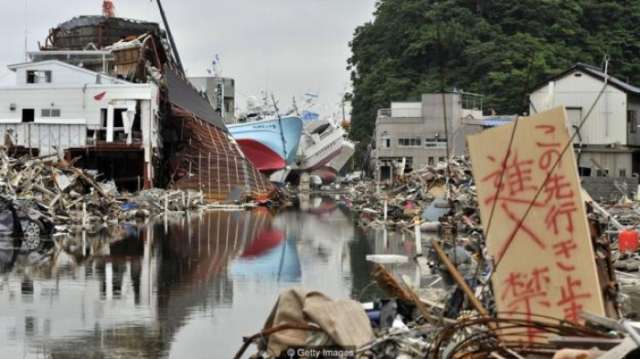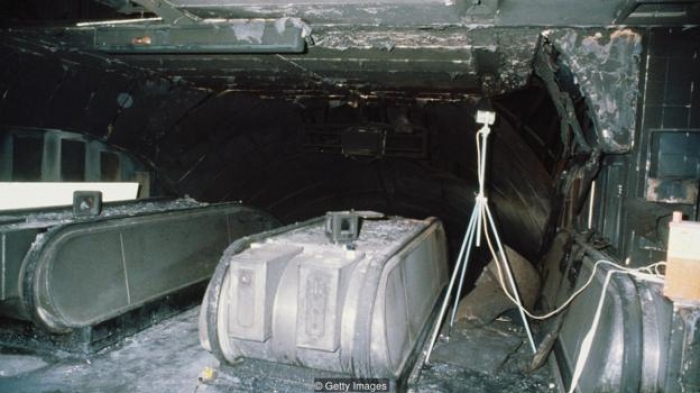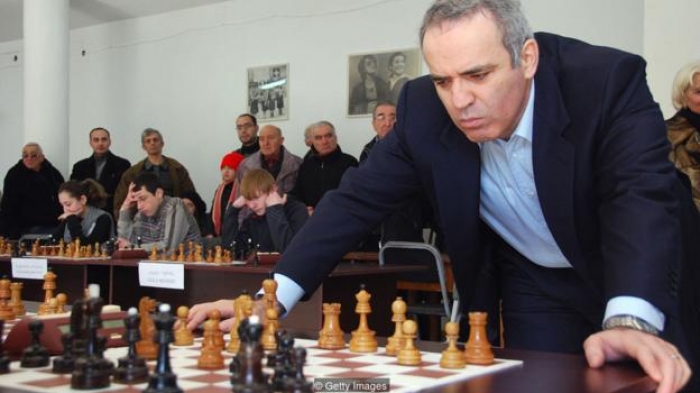The rear end slammed into the ground first. Larson was thrown from his seat. Meanwhile, the plane kept moving. Electric cables sparked and fellow passengers screamed as the fuselage began to split in half.
The next thing Larson knew he was awake, lying on his back on some wreckage. He tried to move his legs, but he was stuck. Soon there was an explosion as the heat ignited fuel tanks by the wings.
As debris rained down all around him, Larson realised he’d have to save himself. With one last breath – “it seared my lungs, the air was so hot” – he pushed off the wreckage and rolled down onto the ground. Then he clawed his way to safety. Of 65 passengers and crew on board, Larson was one of just 17 survivors.
Larson was actually extraordinarily lucky. A few minutes earlier, he had done something ill-advised. He was sitting on the back row, chatting to the flight attendant next to him. Though the seat belt signs were on, he undid his. “No rhyme, no reason, I just did,” he says. The majority of people who unbuckle before a plane crash don’t survive.
However, after the crash, Larson also had the quick thinking and grit to claw himself to safety before the fire spread.

Those not wearing a seatbelt are nearly four times more likely to die in the event of a plane crash (Credit: Alamy)
Surprisingly, plenty of other people in deadly scenarios don’t act fast enough to save their own lives. From arguing over small change while a ship sinks into stormy water, to standing idly on the beach as a tsunami approaches, psychologists have known for years that people make self-destructive decisions under pressure. Though news reports tend to focus on miraculous survival, if people escape with their lives it’s often despite their actions – not because of them.
“Survival training isn’t so much about training people what to do – you’re mostly training them not to do certain things that they would normally think to do,” says John Leach, a psychologist at the University of Portsmouth who survived the King’s Cross fire disaster in 1987. He estimates that in a crisis, 80-90% of people respond inappropriately.
Footage of the Japanese earthquake in 2011 showed people risking their lives while rushing to save bottles of alcohol from smashing in a supermarket. And when a plane caught fire at an airport in Denver earlier this year, evacuating passengers lingered by the plane to watch the flames and take selfies.

During the 2011 earthquake in Japan, people ran to save bottles of alcohol from smashing in supermarkets while their lives were in danger (Credit: Getty Images)
Intelligence doesn’t come into it – the brain fog that descends in emergency situations is reassuringly even-handed. Back in 2001, a lecturer at the University of Cambridge was kayaking in the rough seas off the Isle of Wight when he capsized.
Though he had a mobile phone on board, he clung helplessly to the upside-down boat for more than 20 minutes before he remembered. When he finally retrieved it, first he called his sister in Cambridge – then his father who was more than 5,000km (3,436 miles) away in Dubai. He was eventually rescued when his clear-headed relatives alerted the Coast Guard.
So, if faced with a life-threatening scenario, what behaviours should you do your best to avoid?

When a plane crash-landed in Dubai last year, passengers stopped to collect their bags though the plane was on fire (Credit: Getty Images)
1. FREEZING
When we think of disaster, we tend to think of mass hysteria. In the movies at least, people run away with their arms flailing. But the reality is the most natural human response in the face of danger is to simply do nothing.
During the recent stabbing at London Bridge, an off-duty police officer who tackled the attackers reportedly described members of the public nearby as standing “like deers [sic] in the headlights”.
The reaction is so universal, psychologists now talk of the fight-flight-freeze response.
Though it looks passive from the outside, when we’re paralysed with fear the brain is actively putting on the brakes. As adrenaline surges through the body and our muscles tense, the primitive “little brain” at the base of our necks sends a signal to keep us rooted to the spot.
It’s the same mechanism across the animal kingdom, from rats to rabbits, where it’s a last-ditch attempt to stop a predator from spotting us. But in a disaster, fighting this hangover from our days out on the savannah is vital to survival.
In 2015, Michael Bond wrote an in-depth article for BBC Future on why people freeze. Read more here.

The great fire at King’s Cross Underground station in 1987 killed 31 people (Credit: Getty Images)
2. INABILITY TO THINK
The first clues that our brains tend to go into meltdown under stress came from an alarming discovery.
During the Gulf War in the early 1990s, Israel was bracing itself for attack from Iraq. Following the extensive use of poison gas by the Iraqi army in the 80s, the Israeli government prepared for the worst. Gas masks and auto-injectors carrying the antidote to nerve gas were distributed to the entire population. Israeli families were instructed to select a sealed “safe” room in their homes. On the sounding of an alarm, the public should retreat there – then put on their gas mask.
Between 19 and 21 January, there were 23 attacks. In all, more than 11,000kg (nearly 13 tonnes) of high explosives were dropped on the densely-populated city of Tel Aviv.
Though no chemical weapons were used, more than a thousand people were injured. But not in the way you might think. A closer look at the hospital admissions revealed that just 234 (22%) of the casualties had been directly harmed by an explosion. The vast majority – more than 800 people – had occurred in the absence of any danger. They had occurred during one of several false alarms.
This included 11 cases of death, seven of which were caused by putting on a gas mask and then forgetting to open the filter. Hundreds of people had injected the antidote to the nerve gas though they hadn’t been exposed. Another 40 (mostly sprains and fractures) had occurred while the victim was rushing to the sealed room.
What was going on?
Even at the best of times, our brains are disconcertingly slow – while disasters are rapid. As part of the certification process, aeroplane manufacturers are required to show that the entire plane can be evacuated in just 90 seconds, since studies have shown that the risk of the cabin being consumed by fire sharply increases after this time. Meanwhile, most of us are still fumbling with our seatbelts.

After the World Trade Center attacks, those on the upper floors waited five minutes on average before they evacuated (Credit: Getty Images)
It all comes down to the way we make decisions. Take chess. A typical chess master’s vocabulary includes around 50,000 moves – if the knight is on square x, do y – so the first few moves of a game can be over in mere seconds. But as the game progresses, the more possible positions there are for the pieces on the board. For example, after four moves apiece, there are more than 288 billion combinations.
After a while, players can no longer rely on pre-programmed strategies and must think up their own instead. Then the games slow down a lot. While the first few moves may take seconds, a typical game of pro chess (around 40 moves) takes more than an hour and a half.
This is because actively inventing a new strategy is reliant on working memory, which is responsible for temporarily holding information while we make decisions. “The brain has a very limited capacity for processing new information,” says Sarita Robinson, a psychologist at the University of Central Lancashire.
In a disaster, the speed at which we think through our options goes from bad to worse. The brain’s first port of call is to flood with the “feel good” hormone dopamine. This may seem counter-intuitive, but though it’s usually associated with reward pathways, dopamine also plays a crucial role in preparing the body to face danger. It triggers the release of more hormones, including adrenaline and the stress chemical cortisol. And this is where it gets messy.
This cocktail of hormones shuts down the prefrontal cortex, which sits behind the forehead and is responsible for higher functions such as working memory. Just when we need our wits the most, we become forgetful and prone to making bad decisions.

Like in chess, the speed of decision making in a crisis is limited by working memory (Credit: Getty Images)
3. TUNNEL VISION
In a crisis, it’s reassuring to think that we’d respond by creatively thinking our way around the problem. But – you guessed it, it’s the opposite. A typical response to disaster is so-called “perseveration” – attempting to solve a problem in a single way, again and again and again, regardless of the results. This happens so often, it’s informed the design of seatbelts in light aircraft.
Because people are used to looking for their seatbelts around their hips, in an emergency that’s the only place they look. Previous designs used to involve a buckle higher up, but in the panic of a crash-landing, people just couldn’t handle it. Other incidents have shown that in a crisis, pilots tend to become obsessed with one item of equipment or response.
Intriguingly, this tunnel vision is also seen in those who have permanently damaged their prefrontal cortex, suggesting that the brain’s stress response switching off this region might be to blame for inflexible thinking in moments of crisis.
4. STAYING STUCK IN ROUTINE
Which leads us to the next big stumbling block. “The number of people who have been killed going back to get their wallet from their house, or checking if they’ve left the oven on…” says James Goff, a specialist in disaster and emergency management at the University of Hawaii. After years of working with the public to increase awareness of tsunamis in high risk areas, he’s seen his fair share of unbelievable reactions to a crisis.
On the face of it, risking your life for your wallet seems like madness or sheer stupidity. But it’s extremely common – so common that survival psychologists have a word for it: “stereotypical behaviour”. In animals, the term refers to repetitive and apparently useless routines, such as pacing back and forth in a zoo.
In humans, it refers to the disconcerting phenomenon of continuing with everyday routines, even when, for instance, your home is on fire. “When you leave your house you grab your wallet – you don’t even think about it. It’s automatic,” says Goff.

In an emergency people tend to act as though nothing is happening (Credit: Getty Images)
When Emirates Flight 521 crash-landed at Dubai International Airport last year, footage emerged of passengers scrambling around the smoke-filled plane to collect their bags from the overhead lockers. Fortunately, no passengers were killed as a result (though sadly one firefighter died tackling the blaze). It wasn’t just a one off – the same thing happened a year earlier. And again in 2013.
So why can’t we turn these unconscious reflexes off?
It turns out that in everyday life, our brains are extraordinarily reliant on familiarity. In non-disaster scenarios, mindlessly fetching our bag when the plane lands is thought to help free up mental space to focus on stuff we’ve never encountered before – such as navigating an airport in a foreign city. “We’re in the present but we’re looking to the future by routine,” says Leach.
New situations are extremely mentally taxing, as we work to build up a new model of the world around us – a fact which may explain why we tend to feel so tired when we’re abroad or first start a new job. In an emergency, adjusting to the new situation can be more than our brains can take. Instead, we tend to just press on as though nothing is happening.
5. DENIAL
At the extremes, this extends to completely ignoring the danger altogether. “Invariably over 50% of the population do it, they go down to the sea to watch the tsunami,” says Goff. He has photographs of people watching the Indian Ocean tsunami on Boxing Day in 2004, taken by a person who was racing to get to high ground.
According to Robinson, denial usually happens for two reasons; either because they fail to interpret the situation as dangerous, or because they simply don’t want to. The latter is extremely common in the event of a wildfire, since often evacuating your home means consigning it to ruin.
“People tend to wait until they can see the smoke – and this often means it’s too late to leave. So they’re trapped in a house that is not well prepared for bush fires, or risk being burnt trying to evacuate,” says Andrew Gissing, an expert in emergency risk management at consulting firm Risk Frontiers.

During the recent fires in Portugal, many people perished trying to escape at the last minute (Credit: Getty Images)
For decades, scientists have known that most of us are terrible at calculating risk. When the stakes are high, our brains tend to rely more on feeling than fact, banishing stressful thoughts and reassuring ourselves by explaining away the danger. This may explain why cancer patients wait four months on average before getting their symptoms checked by a doctor, or why after the 9/11 attacks, people on the upper floors of World Trade Center waited an average of five minutes before they started to evacuate.
One person who has experienced denial of the realities of a disaster first-hand is Yossi Hasson. In 2004, he and his girlfriend were scuba diving in Thailand when the Boxing Day tsunami struck. They were underwater, several miles out at sea when it hit – “suddenly I felt as if I had been pushed, hard – then I couldn’t really control anything anymore” – and later returned to the island.
Though the entire seafront was a panorama of destruction, with rubbish and bodies floating all around the boat, Yossi found himself asking if they could go back to the hotel to fetch their luggage. “The boat driver was like, ‘guys, your hotel probably doesn’t exist'”.

When the Boxing Day tsunami struck in 2004, there were still people on the beach (Credit: Michael Spencer/ Wikimedia Commons)
WHAT YOU SHOULD DO IN A DISASTER
At this point you’re probably wondering – if we can’t rely on our natural instincts, what should we count on?
For Goff, surviving a natural disaster is about having a plan. “If you know what you’re doing in advance and you start early, you can usually get away from a tsunami,” he says. “But it might be a bit hairy.”
Leach has years of experience training the military to escape an eclectic mix of chilling scenarios, from hostage crises to helicopters which have crashed into water (top tip: stay in your seat until the fuselage has flooded and turned upside down, then slip out at the last minute to avoid getting caught in the still-turning rotor blades). He knows that the best way around the mental fallout is to replace unhelpful, automatic reactions with ones that could save your life. “You have to practise and practise until the survival technique is the dominant behaviour,” he says.
...BUT SOMETIMES LUCK MATTERS MOST
And what of Larson, survivor of Indian Airlines Flight 440? In the end, the biggest peril for this survivor wasn’t the disaster itself, but what happened afterwards. Eventually he was found by some local villagers who took him to hospital. The fire had been so close by the time he escaped, it singed off the hair on one half of his head. He emerged with first and second degree burns, a broken pelvis, a “busted” arm and damage to his bladder.
To make sure he didn’t have any other internal injuries, his doctors performed exploratory surgery. Weeks later, he had lost weight and the wound still wasn’t healing. On a hunch, Larson’s chiropractor back in the US cut through the stiches and reached in with his forceps. “He pulled out this 30-day old, rolled up gauze that is 12in long.” It was a fortunate discovery – if it had stayed in, his prospects would not have been good.
Preparation, acting fast, busting routines and avoiding denial may all be ways to live a bit longer in worst-case scenarios – but as Larson’s experiences suggests, sometimes you need a good dose of luck too.
More about: #disasters
















































